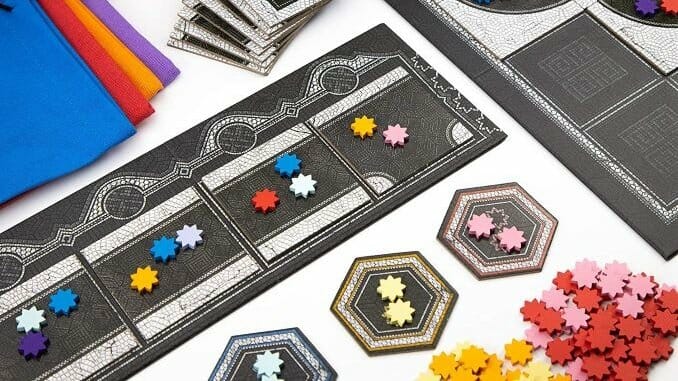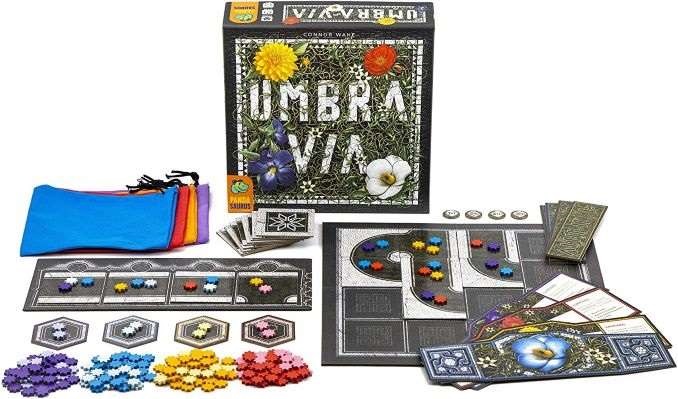
Umbra Via is one of the most perplexing new games I’ve played this year, but ultimately, it just doesn’t work. The first design from Connor Wake, who won the Cardboard Edison Award for the best unpublished game for this same design two years ago, it combines a mini-auction with area control and tile placement mechanics as players try to exhaust their supplies of tokens first, with a result that’s just a jumble of rules and styles that we found more frustrating than fun.
Umbra Via is a pretty abstract game beneath its veneer of a theme, where players are supposed to be guiding their souls through a shadow realm to the afterlife. In each round, players bid on four tiles that show paths on them, going through two rounds of bidding, and will then place the tiles they win, without rotating them, on the main 4×4 board. When a path is completed in any way, you take those tiles off the board and award points to the players with the most tokens on those tiles by allowing them to take some of their special tokens from their supply and move them to their token bag. The first player to remove all of those special tokens is the winner.
Each player starts with two types of tokens, most of them regular tokens in a darker color, with a smaller number of lighter, special tokens. During each bidding round, you remove three tokens from your bag without looking, and then place them on your hidden board to indicate how you want to use them to bid on the four available tiles. Regular tokens count as one bid point each, while specials count as two. (The tokens are called ‘flowers,’ but they look like stars, and the flower part really doesn’t factor into the gameplay at all.) The special tokens you use to bid on tiles are then removed from the game permanently, moving you closer to your goal of being the first to remove all of your special tokens (“soul flowers”) from the game.

Umbra Via is a mish-mash of mechanics and in the end you don’t use any of them enough to satisfy players. The bidding system is very clunky—bidding with just three tokens at a time on four tiles doesn’t leave you with many options, and the two-round system just makes it more complicated without making it more functional, especially since the first round will often leave one or more tiles effectively ‘claimed.’ The tile placement part is the most frustrating aspect of the game, however; you just aren’t building routes here in any normal way. You can’t rotate or move tiles, you’re working on a tiny board, and other players can close a route or make it impossible to close without giving you any way to stop them. It’s like Carcassonne from hell, and each time I played it I found this aspect more and more bothersome. Maybe letting players rotate the tiles—even for payment of some sort—would help. The game also comes with three unique tiles that don’t have paths on them but allow you to do things like move flowers on to or away from adjacent tiles, but in a two-player game those seemed to just add complexity for no benefit.
The two-player game includes a neutral player to create some competition when paths are closed and removed from the main board, which is a smart idea but doesn’t play out that well in practice because the human players take the neutral flowers and put them in their own bags, which will create turns where you only draw neutral tokens to bid and thus end up more or less wasting an entire turn. Umbra Via plays two to four players and can be played in 45 minutes, but I have to say, I just did not connect with this game at all. Everything you’ll find here has been done better in other games—if you want an auction game, look for Power Grid or Ra or Isle of Skye; if you want tile placement with paths, try Carcassonne or Rajas of the Ganges. Umbra Via may just be left in board game purgatory.
Keith Law is the author of The Inside Game and Smart Baseball and a senior baseball writer for The Athletic. You can find his personal blog the dish, covering games, literature, and more, at meadowparty.com/blog.